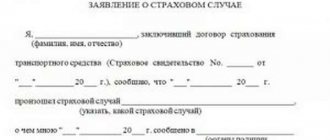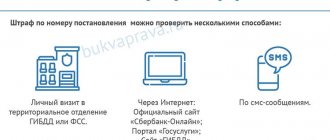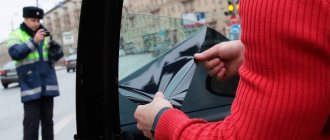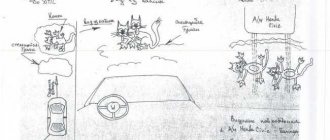The Russian Ministry of Internal Affairs has developed an initiative that should allow citizens to record traffic violations using a mobile phone with a special application installed and send their feedback and information to the traffic police for registration and imposition of fines on traffic violators and those responsible for illegal parking.
In addition to the initiative with the application, amendments to the Code of the Russian Federation on Administrative Offenses were developed, which should resolve legislative “inconsistencies” associated with the recording of violations by ordinary citizens. This all sounds not bad, but in practice it is not so smooth, more on that below.
Goals of recording traffic violators by citizens
On the territory of the Russian Federation, even without a mobile application, there is already a program in place to record traffic violations and receive information from the population.
Under this program, the initiative person is required to take a photo or video recording of the violation, send it to the traffic police and submit an application. Based on such a statement, traffic police officers are required to carry out an investigation, which includes analyzing the sent materials for falsification, and only after that a law enforcement officer can issue a fine to the offender.
The introduction of a mobile application and the legislative amendments that should accompany it will completely eliminate the possibility of falsification, as well as simplify the procedure for approving the fact of an offense and subsequently issuing a fine.
How to send a photo from your phone and report a violation?
The official mobile application recording traffic violations will work as follows:
- A citizen must install the application from the State Services portal, having previously logged in with his username and password. This is done to identify application users.
- How to complain about a traffic violation? When a traffic violation is detected, the user launches the application and films the fact of an administrative offense so that the car number is clearly and clearly visible, and also so that the fact of the violation can be accurately determined from the footage (for more information about whether ignoring traffic rules is an administrative violation or not, you can find out here).
- Where to send? After filming the violation on a smartphone, the citizen sends the footage to the traffic police, where employees manually evaluate all the data sent and, after analyzing the recording, issue penalties for the offenses.
Important! Since an Internet connection is required to send information and determine the exact geographical location of the shooting location, the fact of connecting to it will be a prerequisite for recording a crime.
How to report illegal parking?
Expert opinion
Zakharov Viktor Yurievich
Practicing lawyer with 8 years of experience. Specialization: family law. Recognized legal expert.
There are various ways to inform the competent authorities about a violation of parking rules. This could be a phone call or personal contact.
This is important to know: Statement to the police regarding fraud: sample 2021
For greater guarantee, it is necessary to record the violation. The most suitable option is photography. After this, the specified materials are sent to the authorized authority to take action against the violator. In this case, the applicant has the opportunity to learn about the results of consideration of the application.
Taking the correct photo of a parking violation
Taking photographs is the best option to record a violation of parking rules. But it must be correct. It will not be enough to remove only the vehicle itself. A panoramic photograph is required, which should reflect:
- vehicle;
- his state number;
- parking place;
- sign prohibiting parking;
- date and time of the photo.
If such information is available, the photograph will be evidence of the violation.
In addition to the photograph, you must attach information about:
- date and time of the offense;
- the place where the illegally parked car was found;
- vehicle data – make, state registration. numbers;
- type of offense and the violated article of the Code of Administrative Offenses (if the applicant can provide such data).
Determining where to send a photo of a parking violation
After a violation has been recorded, the images must be sent to the authority whose competence includes taking action against violators. This is the traffic police (formerly the traffic police). It is the State Traffic Inspectorate that reviews materials on cases of non-compliance with parking rules, since they are a violation of traffic rules.
You can also file a complaint with your local administration. The submitted materials will be transferred to the traffic police for consideration.
Residents of Moscow and the Moscow region can contact the Moscow Administrative Road Inspectorate (MADI) through the Autocode resource.
We report violations of parking rules to the traffic police
You can send a complaint to the traffic police using various options. First of all, this is a personal appeal. In this case, the applicant independently brings the available materials to the traffic police and files a complaint. The appeal can be both individual and collective. The latter option most often concerns cases where car owners violate parking rules in the courtyard of a residential building.
You can also contact the traffic police remotely. To do this, you need to use the traffic police website. The algorithm of actions of the interested party will be as follows:
- Login to the main page.
- Select the “Services” > “Receive Requests” section.
Read and agree to the terms and conditions, click “Submit an appeal”.
Fill out the form and attach a photo of the violation.
Fill out the captcha and click “Submit request”.
In the “Text of appeal” section you can indicate:
Photos are attached in the attached file.
Based on the above and guided by clause 3, part 1, art. 28.1 Code of Administrative Offenses of the Russian Federation, Federal Law dated May 2, 2006 N 59-FZ “On the procedure for considering appeals from citizens of the Russian Federation”,
- Identify the driver who was driving the vehicle at the time indicated above and initiate proceedings against him for an administrative offense under Part 6 of Art. 12.19 Code of Administrative Offenses of the Russian Federation
- Give a written response to the request at the specified postal address within the period established by law.
October 01, 2021 Ivanov I.I.
Waiting for a decision
Applications through the website are considered within the time period specified by Federal Law No. 59-FZ of May 2, 2006 and Order No. 707 of the Ministry of Internal Affairs of Russia dated September 12, 2003. It is 30 days from the date of registration of the application . The request is recorded within three days from the date of receipt. The period for consideration of a complaint may be extended, but not more than by 30 days. The applicant is notified of this.
The applicant is notified of the results of the consideration of the complaint within the specified time frame. Information about the measures taken against the violator is sent to the applicant’s email in the form of a scanned copy. Information about the stage of consideration of the complaint can be obtained by filling out the standard complaint form and indicating the registration number of the complaint.
Will there be bonuses for filing complaints? Or free?
As of February 2021, there is no decision on whether any bonus will be paid to the citizen who helped fine the offender. At the same time, an initiative is being considered at the government level, according to which the applicant will be paid 10% of the amount of the fine that was issued at his request.
Since 2015, a mobile application “Moscow Assistant” has been operating in Moscow to record traffic violations by citizens, with which you can report violations. Through it, residents of the capital can report violations of parking rules and non-payment of parking in paid parking lots. For this, they are awarded bonuses that can be exchanged for souvenirs or minutes of free parking in the center of Moscow.
How to record a traffic violation using the Moscow Assistant application
The Russian Ministry of Internal Affairs has taken the initiative to create an opportunity for citizens to help the traffic police in detecting and recording violations of traffic rules. To implement this idea, the Moscow Assistant application was created. It allows you to take photos and videos of traffic violations on your smartphone, and then send the data directly to the traffic police. The traffic police officer checks the information received and, if there is a violation, issues a fine to the culprit.
What to do if you see a traffic violation?
To send information about a traffic or parking violation, you need to:
- Register on the capital's State Services portal mos.ru and fill out your profile.
- Download “Moscow Assistant” in the AppStore or Google Play.
- Log in using your State Services username and password.
- When someone in sight commits an offense, you need to launch the application and take a photo or video, following the instructions.
- It is necessary to take photos from different angles so that the license plate number of the car, as well as the offense itself, is clearly visible.
- The application system automatically recognizes the car number and offers the user options for confirmation.
- The footage is sent via the application to traffic police officers, who manually evaluate the information received and issue a fine if an offense actually occurred.
Please note: when recording a crime, you must connect your smartphone to the Internet so that the application can determine the geolocation. However, given the fact that now almost all smartphone owners purchase an Internet package for a month, this should not lead to any difficulties.
Bonuses for reporting violations
Today, the Moscow Assistant application already has a bonus program. By reporting unauthorized parking or non-payment for a parking space through the service, the user receives bonuses that can be exchanged for free parking minutes or souvenirs. Detailed information about the use of bonuses, as well as a map of violations by district and a rating of the most active citizens can be found on the official website of the application assistantmoscow.rf.
Pros and cons of the program
The idea of recording traffic violations by ordinary citizens has both positive and negative sides. The undoubted advantages of the appearance of the Moscow Assistant application and others like it include:
- an increase in the number of recorded offenses, which leads to an increase in budget revenues and the development of road infrastructure;
- using the application helps people develop an active civic position, helps, within the framework of their powers, fight against violations of the law, and feel involved in the life of the city and country;
- As residents use the app, they learn to take responsibility for what happens in their city.
But the use of such applications also has weaknesses, most of which are technical:
- At the moment, in order to record a traffic violation, you need to launch the application and log in to it. This takes time, and it is not always possible to quickly remove the offense;
- the list of violations available for recording by citizens is rather ill-conceived: it does not include those offenses that most affect pedestrians and can be easily recorded by them, for example, driving on the sidewalk or roadside;
- To date, the procedure for challenging a fine issued on the basis of information received through the application is not clearly defined. And those who try to appeal such a fine often face difficulties.
Pros and cons of the program
The legislative initiative to introduce a mobile application for recording traffic violations in the everyday life of an ordinary citizen has obvious advantages and disadvantages. The advantages of such a tool include the following:
- The number of recorded offenses will increase, which means that the budget will be replenished by a larger amount and the state will be able to afford to invest more in road infrastructure.
- Citizens of Russia will be able to demonstrate an active civic position and help, within the framework of their powers and competencies, to suppress offenses on the part of road boors.
- Citizens of Russia, thanks to the emerging tool, will be able to increase internal civic responsibility for what is happening around them.
Unfortunately, this initiative is not without its drawbacks, most of which are purely technical:
- According to the current technical specifications for the application, in order to record an offense, a person will have to launch the application using the login and password from the State Services portal. This delay may not allow recording transient violations: driving through a red traffic light, disembarking passengers in the wrong place, and so on.
- The list of violations that can be recorded using the application from the traffic police looks strange. Thus, there are no violations for driving on the sidewalk or the side of the road, and these are the offenses that are easiest to record for a pedestrian.
- The bill does not stipulate the procedure for a citizen to challenge a fine issued to him for violating traffic rules based on an application through a mobile application.
Expert opinion
Suvorov Mikhail
Leading lawyer-partner of the Legal Center
My opinion is twofold. On the one hand, it is good that citizens will be able to actively fight traffic offenders, in particular illegal parking. On the other hand, how can a vehicle owner prove his innocence if his car was driven by another person? Also, a photo of the offender can be taken from an angle in which the “offence” will be visible, although in fact the driver did not violate anything.
8 (800) 350-14-90
Mobile application for complaints about traffic violations: complicating simple tasks
Inconvenient and offensive
There is no application yet in nature, but there is a description of it - in fact, a technical specification for development.
And from this it is already clear that the legislator is “reinventing the wheel.” Firstly, using such an application will be inconvenient. Those who want to record a traffic violation will be forced to first register on the State Services portal, then download the application to their smartphone and, finally, log into this application, which is impossible in the absence of the Internet. Secondly, such an algorithm demonstrates clear disrespect for citizens who are obviously suspected of trying to falsify materials made using an ordinary camera or video recorder.
If the driver of another car wants to report a violation, then it would be much easier for him to use his DVR by downloading the video to his computer and sending the file by email. Not to mention the fact that using a mobile phone while driving is strictly prohibited, one can only imagine how much time it will take to work in a special application when a person is rushing to work or about his business.
In addition, by the time he enters some codes and a password for “Gosuslug”, all the violators will have quietly left, so there will be no one to shoot.
The application is only good for those who have a lot of free time. Having taken a position on some difficult section of the road, you can spend hours “catching” violators who are accustomed, say, to driving under a prohibitory sign or through a solid marking line. But sitting in ambush is the favorite method of work of traffic cops - ordinary citizens, as a rule, have no time for it. So who is this application intended for?
Strange selectivity
The second oddity of the bill is revealed when analyzing violations that can be recorded on the Unified Portal of State and Municipal Services using technical means with video recording functions and specialized software.
Articles / How to properly prove your innocence in an accident or violation using video? The State Duma approved in the third reading a bill on mandatory equating video, photo, audio recordings, as well as materials from information databases and other information media to documents... 22677 0 41 04/19/2016
The proposed amendments to the Code of Administrative Offenses propose to fine car owners for violations of traffic rules across railway tracks, driving through a prohibiting traffic light signal or a prohibitory gesture of a traffic controller, violating the rules for driving through intersections, maneuvering and positioning a vehicle on the roadway, failure to comply with the requirements prescribed by road signs or markings, as well as for failure to give priority in traffic to pedestrians or other road users.
The question immediately arises: why was driving on the side of the road or on the sidewalk not included in this list? After all, it is precisely this kind of violation that is easiest to record for a pedestrian whose movement is impeded by someone’s car. Maybe the list should be clarified again?
Again without the presumption of innocence?
The explanatory note to the bill states that the video materials will be viewed by State Traffic Inspectorate employees. They are the ones who classify the violation and identify the driver by car number, and then, if there is reason, they will issue a fine. And although this will be done “only if there is sufficient data indicating the event of an administrative offense,” another logical question arises - how can a person identified by car number prove his innocence?
Currently, photo or video materials obtained with the help of devices that are not special technical means included in citizens’ appeals are subject to consideration only in conjunction with other materials (witness testimony, explanations of persons being investigated, etc.).
The authors of the bill really don’t like this, since “the consideration of such appeals entails significant time and resource costs for State Traffic Inspectorate employees in the process of proving the circumstances of the offense (calling the person who provided information about the offense event, identifying the alleged offender from data banks, calling him for questioning, establishing additional witnesses, deciding on the admissibility of video recordings as evidence).”
But it is precisely this procedure that makes it possible to eliminate abuse of rights.
In our country, there is already no presumption of innocence in cases where traffic violations are recorded by traffic cameras. But these cameras are installed according to special rules, they are certified, tested, and are announced on road signs.
If information about a vehicle allegedly violating traffic rules is received through a mobile application, then traffic police officers must judge the event of an administrative offense solely according to the law, that is, in compliance with all procedural rules.
Otherwise, we may face numerous cases of sweeping accusations, when, out of a sense of revenge or simply hostility towards the owner of the car, they will specially film it from an angle that would suggest a violation of traffic rules even where there was obviously none.
Articles / How to use the recorder correctly so that the court accepts the video How sometimes we lack a powerful argument in our favor, in favor of our innocence! Just imagine... A traffic police inspector stopped you and said that you were exceeding the speed limit, crossed the road... 34607 0 87 04/23/2015
As an example, we can cite cases of avoiding an obstacle through a solid line. You just need to film the “intruder” in such a way that the obstacle (which the person filming can deliberately place on the road) is not visible, but the fact of hitting the marking line is clearly visible.
Even in cases where the car owner receives “chain letters,” he is still protected from obvious errors. For example, recently a fine was canceled when the violating car was not moving under its own power, but on a tow truck, and this was clearly visible in the photograph. Although there is an obvious oversight by an employee who was obliged to look at the photo, make sure that there really is a violation and identify the violator - the tow truck driver who exceeded the permissible speed.
Amateur video footage should be viewed even more carefully to make sure that the violation was committed by the exact car that was captured in the frame, and that the location and time of filming correspond to those stated. Finally, that the person suspected of committing an offense does not have an alibi or any other justification (and for this he must be interviewed). Only after this can a fine be signed. Otherwise, we may face such chaos that we don’t even want to think about right now.
From the editor:
Unfortunately, when considering the initiative with a mobile application, we again come to the conclusion that any good idea can be ruined by poor execution by people without the good will to stop violations. For example, is it a good idea to punish aggressive drivers? Undoubtedly. Is there a danger that the “human factor” of traffic police inspectors will ruin everything? Eat.
It's the same with the mobile application. Is it fair that now, having filmed a violator on your phone, you then need to “walk with your feet” to the investigator and waste your time on testimony? No. Need to simplify the procedure? Need to. Is there a risk of police misconduct? As always.
The lawlessness of employees of the Ministry of Internal Affairs is, unfortunately, a certain reality in Russia, with which absolutely nothing can be done without radical measures such as lustration on the Baltic model. There are no prospects for lustration, and small private violators need to be fought right now. Therefore, I see no reason to “bury” the idea of a mobile application for complaining about violators.
Survey
Will you report violators using the application?
Your voice
Total votes:
Existing mobile applications for Android and iOS
While the federal government is trying to approve at the legislative level the initiative of the Ministry of Internal Affairs to record violations of traffic rules by ordinary citizens through a mobile application, the Moscow authorities and the social project “SPOT” have released their applications. Let's see what they are called and how a complaint message is sent with photos and/or videos recorded online.
Expert opinion
Suvorov Mikhail
Leading lawyer-partner of the Legal Center
Dear readers! When filing a complaint through applications, we advise you not to indicate contact numbers and home address. By law, it is enough to indicate the email address registered in the communication application.
8 (800) 350-14-90
Download SPOT to send violations to the traffic police (formerly traffic police)
The SPOT application works as follows:
- The user launches the application.
- Makes photographic recordings of traffic violations.
- Enters into the form the license plate number of the car that violates the traffic rules.
- Checks the validity of a specific address.
- Select the type of violation from the drop-down list.
- Sends an electronic application to the traffic police by pressing the appropriate button.
Reference! The application form is filled out automatically by the application; a unique email address is generated for submitting the application itself, which allows you to track the status of each individual application. - NIBDD employees consider all incoming applications in accordance with Federal Law No. 40 and Order of the Ministry of Internal Affairs No. 707.
And they are required to respond to citizens electronically. This answer comes in the application.
It should be noted that the SPOT application can be downloaded for the two most common mobile platforms: Android and iOS.
Spot - record traffic violations from your mobile phone
On whose behalf will the application be sent to the traffic police?
On your behalf, because you are the witness of the offense, and we only provide a convenient tool for recording it.
Isn't this dangerous? Will the offender know who complained?
This is not dangerous. The offender has the right to familiarize himself with the case materials, which will contain your full name and email address in the format . If you are still afraid, then first try to find a small, inexpensive car and photograph it. Perhaps then you will go into a rage.
Do I need to go to the traffic police?
This very much depends on the city/area in which the violation occurred. So far, many inspectors are asking to come to the traffic police to give explanations and provide photographs. This is due, first of all, to problems within the traffic police itself. Most often, your failure to appear does not in any way affect the course of the investigation, however, there are cases when inspectors did not initiate proceedings without appearing. Keep in mind that this is illegal and, having collected the remaining number of cases, we will take them to the prosecutor's office.
If I’m ready to go to the traffic police, then what awaits me there?
You will be asked to write an explanatory note, provide personal information, and possibly bring photographs. So that you do not waste a lot of time at the traffic police, we recommend that you take ready-made explanatory notes from us, which you only need to print out, indicating your date of birth and signing. We also do not recommend leaving any personal contacts with the traffic police: telephone numbers, addresses, personal email, etc. The application contains an email address - you can be contacted using it.
How to take photographs correctly so that applications are not rejected?
Everything is very simple. The inspector must see the photographs and immediately understand that such and such a violation occurred in such and such a place, committed by the driver of such and such a car with such and such a license plate. This means that it is necessary that the photo shows:
1. Car number to know who to punish;
2. The violation itself (if a sidewalk, then a curbstone; if a crossing, then a zebra crossing and a crossing sign; if there is a parking space for a disabled person, then a parking sign with a “disabled person” sign; if the second row, then a photo from behind is required to show the absence of an emergency warning sign stops; if the parking lot is under a sign, then the sign itself is next to the car);
3. The surrounding world: shops, museums, cinemas, monuments - any immovable objects by which the location of the crime can be determined. Ideally, an address sign on a nearby building.
4. The absence of a driver in the car is an important point, because... does not allow the violation to be interpreted in two ways.
To be able to photograph all this, we made an “Add Photo” button. You can attach up to 5 photographs to one application.
Can I upload a photo from the gallery?
Photos can only be taken from the application. There are two reasons for this: firstly, it protects us from fakes, and secondly, it protects us from hundreds of old photographs. After all, you have only 2 months to charge a person with a violation. Accordingly, the “fresh” the photograph, the more time it takes to bring to justice.
I submitted my application, what next?
Then, right in the application, you will see the status of the application - at what stage it is. Responses from the traffic police will be sent to the application and duplicated to the email through which the account is registered.
Will the person get a fine right away?
Not yet, unfortunately. Based on the statement and photographs, an administrative investigation will be initiated, as a result of which the violator may be held accountable. According to statistics, approximately 23-24% of violators end up receiving fines.










